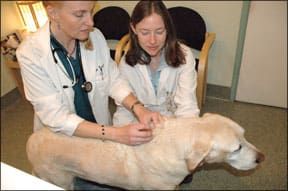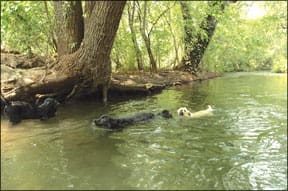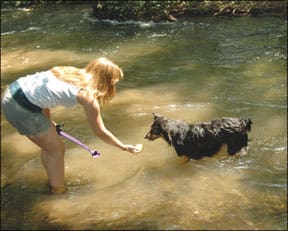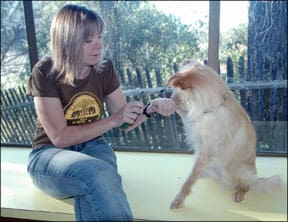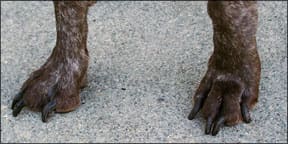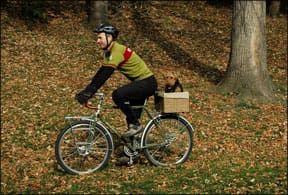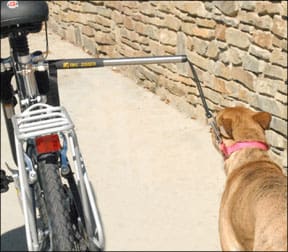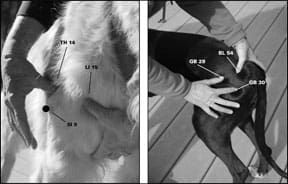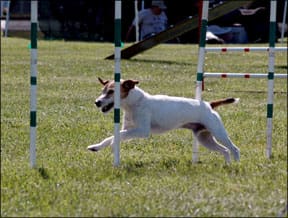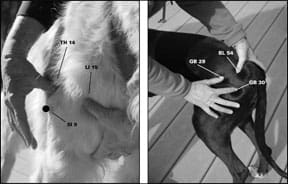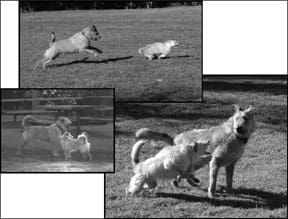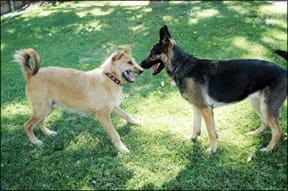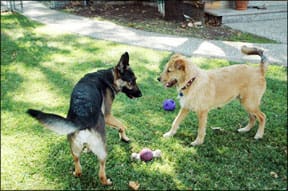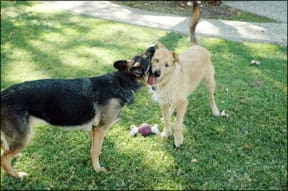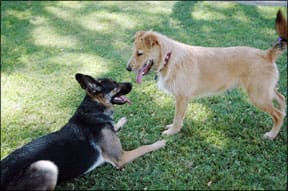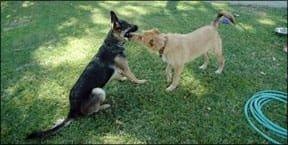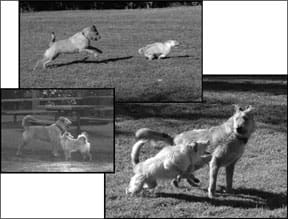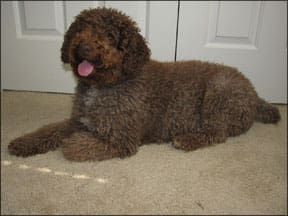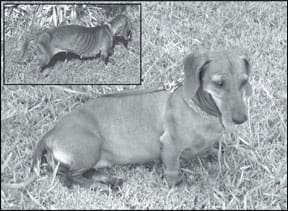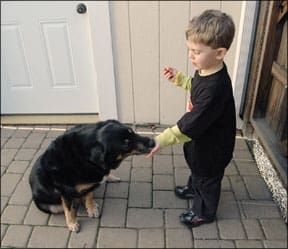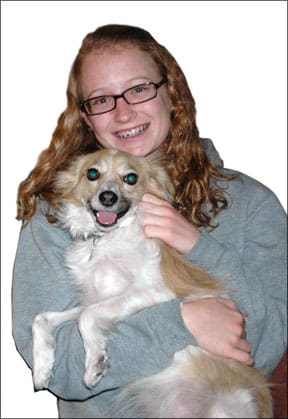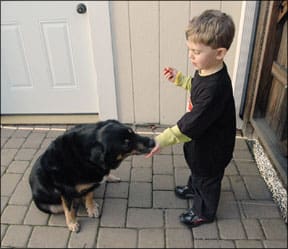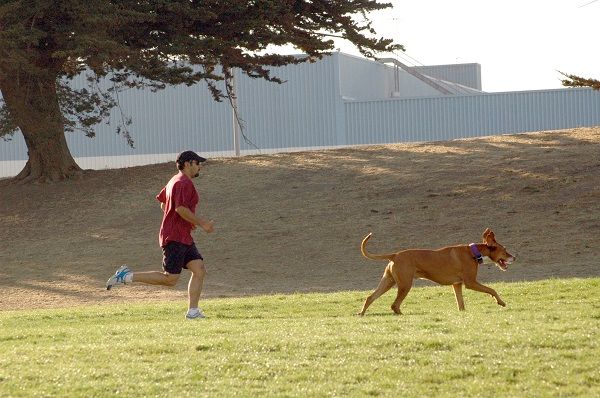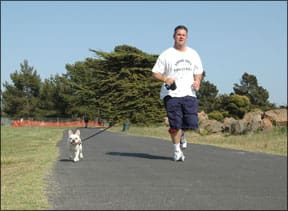[Updated February 27, 2018]
Last year my Border Terrier, Dash, received advanced canine dental treatments to the tune of more than $2,500 (described in “Improve Your Dental Acuity“). Her root canal, surgical extraction, and periodontal treatments were necessary to improve her health, but they certainly stretched my checkbook until I could hear the twang!
Fortunately, I was able to afford these procedures. But, who knows what could happen next to either of my two dogs, and how much it might cost? And how can I be prepared to provide a lifetime of high quality healthcare when my next puppy comes along? For the first time I am seriously considering the benefits of pet health insurance for my dogs (both seniors), and, especially, for any young dog who joins my family in the future.
Advances in veterinary science have led to the availability of high-tech wellness care, diagnostic testing, treatments, and surgical procedures. Cancer care, MRIs, pacemakers, joint replacements, and, yes, advanced dental care are increasingly common. Many private veterinary practices now offer high-tech procedures previously offered only at regional, specialty referral clinics.
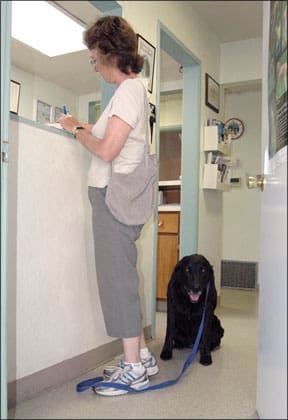
The American Pet Products Association (APPA) estimates that, in 2008, dog owners spent more than $10 billion on veterinary care. The APPA’s 2007/2008 national pet survey reported that the average “routine veterinary visit” for a dog cost more than $200, and the average “surgical vet visit” cost more than $450. Advanced, high-tech treatments cost much more.
If you want to provide your dog with high quality healthcare throughout his life, pet health insurance deserves a serious look. And since you can’t buy health insurance for your dog when you really need it most, like in an emergency, or when a pre-existing condition erupts into a critical situation, now is the best time to look into health insurance that could save you hundreds or even thousands of dollars.
Available Pet Insurance
Currently, a number of companies offer some type of pet health insurance in the U.S. Just like with human health insurance, there are several vastly different types of coverage a pet owner can buy. Classic pet health insurance is intended to cover expensive, unplanned events. Like health insurance policies for humans, most canine policies come with monthly premiums, a variety of deductible choices, various coverage levels, co-pays, and caps that limit total annual or lifetime payouts.
Canine health insurance policies may exclude older dogs or particular breeds from coverage, as well as certain genetically based conditions common to particular breeds. The policies normally exclude pre-existing conditions and may offer discounts for covering more than one pet member of a family.
Wellness coverage is one of the many choices available in classic insurance policies, along with prescription drug coverage, cancer treatment coverage, alternative therapies, accidental death, etc. Wellness packages generally offer preventative services such as vaccines, annual check-ups, and blood tests at a set rate.
Then there are variations – policies that cover only catastrophic illnesses, or, at the other end of the spectrum, plans that cover catastrophic care as well as regular wellness care and even alternative therapies like acupuncture. Some have options for dental care and prescription drug coverage. Some policies include a lost pet recovery service option or other “value-added” incentives. Of course, the costs for these plans vary significantly.
Insurance is the most effective method of mitigating high-tech veterinary expenses, but it’s underutilized. I asked Dr. Tim Banker, a member of a Greensboro, North Carolina, primary care veterinary practice (and my dogs’ dentist), about the practice’s experiences with pet health insurance. “Only five clients have involved us in the claims process,” he said.
One possible barrier to widespread acceptance by many pet owners is the persistence of stories about insurance companies that fail to cover what owners thought they would cover. It sometimes seems that unless the veterinarians fill out the paperwork just so, with the codes and abbreviations aligning properly, like stars in the heavens, many claims go unpaid. “There is an ‘art’ to knowing how to define the dental condition so that the insurance company accepts it,” Dr. Banker says.
I asked Dr. Banker if his specialty practice offered in-house discounts on expensive procedures to clients without insurance coverage. “Special programs are related to wellness services where there is more profit margin to work with. Advanced dental services are much more expensive to provide,” he explained. In other words, insurance is the best way for an owner to manage these expenses.
Understand These Insurance Terms Before You Shop:
The world of health insurance has a language of its own. We’ve defined some of the terms you should be familiar with:
Benefit schedule — Allowable charges for specific treatments defined by the insurance company in its policy. These charges may or may not equal the actual charges billed by your veterinarian for the treatments.
Co-pay — The portion of each veterinary bill the policyholder must pay before the insurance company becomes responsible for its payment. The amount varies according to the individual policy and is not cumulative. For instance, if your policy calls for a $20 co-pay, you must pay $20 toward each and every veterinary bill invoiced in the policy period.
Coverage level — Restrictions outlining the payment responsibilities of the insurance company, including maximum payout amounts, types of treatments included in the plan, and types of conditions included in the plan.
Deductible – The portion of the veterinary bill the policyholder must pay before the insurance company becomes responsible for any payments. The amount varies according to the individual policy and is cumulative. For instance, if your annual policy calls for a $500 deductible, you will have satisfied your deductible after having paid $500 in veterinary bills during the plan period, and the insurance company will pay future bills invoiced in the policy period according to other policy guidelines.
Premium — The cost of the health insurance policy, usually paid to the insurance provider monthly or annually.
Wellness care — Usually an add-on to a health insurance policy to cover preventative
treatments like regular dental cleaning, heartworm testing, and fecal exams.
Ask These Questions First
All of these companies offer price quotes through their websites and/or over the phone. Once you have determined the type and level of coverage you want for your dog, and you have some price quotes in front of you, call the companies whose plans you are considering and ask the following (and get the answers in writing!).
• What are the age limits? Some companies require puppies to be at least eight weeks old before coverage starts. Others will not cover older dogs.
• What is your waiting period? How long after you purchase the policy will you have to wait before all of the benefits kick in?
• What are your exclusions for pre-existing health conditions? How do you determine what is pre-existing?
• Does the company exclude certain breeds, charge more for certain breeds, or exclude breed-related, genetic conditions from coverage?
• What are your coverage caps or ceilings? Do they apply per incident, per body system, per illness, per year, or over the dog’s lifetime?
• How do you cover chronic or recurring illnesses? Does coverage continue for repeated treatment of the same condition?
• What triggers an increase in premiums? The dog’s age, filing a claim, built-in annual increases?
• Does the policy pay benefits based on a pre-determined schedule of charges or on the actual vet bill you pay?
• What are my co-pay choices? What percentage of my cost will the policy pay? Will my co-pay amount increase as my dog ages? Will my co-pay increase if I visit an emergency or specialty veterinarian?
• What are my deductible choices? Are deductibles different for visits to primary care veterinarians than for treatment by emergency or specialty veterinarians?
• Can I change my policy before the renewal date? If I do so, will I be charged a fee for the change?
• Can I get a multi-pet discount?
• How long after filing a claim will I receive reimbursement?
• Exactly what is covered and not covered in the policy? Checkups, spay/neuter, accidents, alternative therapies, preventative care, prescription drugs, illness due to tainted food?
• Can I use my usual primary care and specialty veterinarians, or must I use an in-network provider to receive benefits?
Pet Insurance Company Descriptions
Let’s look at the companies that are currently in operation.
AKC Pet Healthcare Plan
Underwritten by Markel Insurance Company, the American Kennel Club describes its plans as offering “individual claim evaluation, without complicated procedure limit maximums or benefit schedules.” That approach works as long as the evaluator agrees with your assessment of the reimbursements owed to you from the insurance company. There’s a 60-day Trial Plan, if activated within 28 days of AKC registration, for purebred dogs. The AKC also offers a plan that provides only accident coverage, at extremely low rates, so owners can cover “‘unlucky’ situations [listed in the plan] that frequently lead to high vet bills,” such as bite wounds, trauma, lacerations, fractures, and poison ingestion.
AKC Pet Healthcare Plan
Raleigh, North Carolina
(866) 725-2747
ASPCA Pet Health Insurance
The ASPCA has offered pet health insurance since 1997, and currently offers five pet health insurance plans with increasing levels of coverage. Owners must purchase the additional “continuing care option” for each plan if they want plan coverage for an illness or injury that showed symptoms or was treated in one plan period and requires care in another plan period, unless 180 days have passed from cure and last treatment. Some of these illnesses are relatively common, like allergies, diabetes, osteoarthritis, and cancer. The plans exclude acupuncture, chiropractic, and rehabilitative therapies, and vaccine antibody titer testing.
ASPCA Pet Health Insurance
Canton, Ohio
(866) 820-7764
Embrace Pet Insurance
Laura Bennett, a co-founder of Embrace Pet Insurance, wanted to offer pet health insurance policies that were not just “small, medium, or large.” She designed Embrace’s plan to give consumers many choices. Embrace offers more than 108 coverage variations so they can customize a plan for any particular dog living in any area. “We customize policies according to risk based on the type of pet and where you live,” she explains.
Embrace considers the hereditary conditions common to a dog’s breed, chronic conditions already present in the dog, and the area of the country in which the pet and owner live, all of which dictate the anticipated cost of healthcare for the dog, when pricing a policy. Then, Embrace offers additional coverage programs for things like wellness care, alternative medicine coverage, dental care and prescription drug coverage, which the owner may select as desired.
In its third year of selling pet health insurance, Embrace now covers about 5,000 pets and is growing about 25 percent a year. The company pays benefits according to actual amounts billed by the veterinarian, not a predetermined schedule of charges. Its goal is to provide reimbursements within 15 working days. You can “back into” the process by starting with the premium you’d like to pay and then putting together a shopping cart of benefits you want for your dog within that specified premium amount.
Bennett suggests that veterinary care costs are rising about 7 percent a year. Still, less than 1 percent of pet parents in the U.S. carry pet health insurance, compared to the 25 percent of pet owners, and 60 percent of purebred dog owners, with health insurance for their pets in England. “Pet health insurance is a great financial management tool,” says Bennett.
Embrace Pet Insurance
Mayfield Village, OH
(800) 511-9172
Pet Assure Corporation
“Simple” is the guiding philosophy at New Jersey-based Pet Assure Corporation, owned by Charles Nebenzahl. He purchased the company two years ago from its founder, who had been refused insurance reimbursement for his Labrador’s hip dysplasia treatments because it was a genetically-based condition and therefore excluded from his policy. The founder channeled his frustration into creating Pet Assure, a type of financial protection from pet healthcare expenses that doesn’t deal in forms and paperwork, deductibles, co-pays, pre-existing conditions, medical care codes, pre-determined schedules of charges, or other complexities.
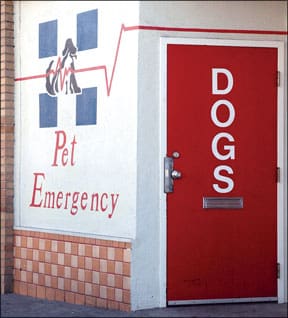
Pet Assure more closely resembles a discount club than an insurance company. It signs veterinarians up when the vets agree to provide a 25 percent discount on medical services to Pet Assure members. Pet owners pay an annual fee and receive a membership card to present at the time of veterinary treatment provided by an in-network provider.
Why would vets mark down their service charges for Pet Assure members? “Most costs are fixed, but the veterinary practice may not be filling all of its appointment slots,” says Nebenzahl. He says Pet Assure brings new clients who want to receive discounted services to participating veterinary practices.
Pet Assure members can plug their zip code into the company’s website and receive a list of participating vets in their area. Urban areas around Washington, DC; New York City; Miami; Los Angeles; and in New Jersey offer the broadest choice of Pet Assure in-network veterinary practices. Some veterinary practices extend the discount to adjunct services like boarding and grooming.
Most of the participating veterinary practices are primary care clinics. “[Veterinary] specialty practices are busy and don’t need help to fill [appointment] slots,” Nebenzahl says. But specialty practices are where pet parents most often spend the big bucks and need the most financial assistance. “Our program is designed to pay for itself with routine veterinary care only,” Nebenzahl explains. Pet Assure also offers a “simple” lost pet recovery option. No microchips, no fancy chip readers. Just a collar tag with an ID number that directs someone who has possession of your lost dog to contact Pet Assure by phone. Pet Assure will identify and locate the dog’s owner.
Pet Assure Corp.
Lakewood, NJ
(888) 789-7387
PetFirst Healthcare
Offering premiums unaffected by a dog’s age, breed, or location, PetFirst Healthcare provides “core” plans (Basic Plan) and “comprehensive” plans (Preferred and Preferred Plus Plans), depending on the breadth of coverage desired by the owner. The plans are renewable for the life of the dog as long as the policy is purchased before the dog’s 10th birthday. The plans have per incident maximum payouts and a $50 deductible per incident for accident and illness claims. PetFirst provides a small discount, with coverage starting immediately upon adoption, for dogs rescued from shelters.
Bill Watson, Executive Director of the Roanoke Valley SPCA in southwest Virginia, began offering a PetFirst Healthcare insurance policy to shelter dog adopters in 2006. Although the shelter’s veterinarian carefully screens dogs available for adoption, and the shelter would never knowingly adopt out a sick animal, Watson says it’s not always possible to know what an animal could be incubating. “The worst calls I get,” says Watson, “are when an adopter gets home and later calls to tell me their animal is sick. They don’t always understand the communal nature of shelter living. I get a small number of these calls but they are highly emotional.”
Now, the shelter offers adopters the option of purchasing a pet health insurance policy, which takes effect on the adoption day, for just $5 for the first month’s premium. The premiums revert to the regular rate after the first month.
Watson credits the shelter’s constantly improving medical practices and the availability of affordable pet health insurance with reducing adoption returns for health reasons from 20 to 25 per year to three to five per year.
PetFirst Healthcare
Jeffersonville, IN
(866) 937-7387
PetHealth, Inc.
PetHealth, Inc., based in Ontario, offers a range of similar products and services for veterinarians, shelters, and pet owners through a number of wholly owned subsidiaries using a number of brand names including 24PetWatch, CherryBlue, EVE, PetPoint, and ShelterCare.
Pethealth offers a wide range of plans, from accident coverage only to full plans with accident and “double illness” coverage. It also offers a special “tenant” plan, for dogs who live with their owners in rental homes, and a plan for senior dogs, which covers the maladies that most commonly affect senior dogs.
Available in the U.S. (except in Alaska) this company guarantees acceptance regardless of the age or current health of the dog. It notes that premiums and coverage don’t increase due to a pet aging. Owners can purchase extra coverage for hereditary conditions. Some plans even provide temporary partial reimbursement for the purchase of special diets.
PetHealth, Inc.
Buffalo, NY
(866) 275-7387
Petplan USA
Petplan USA claims to be the only pet health insurance company in the U.S. to cover hereditary diseases with no dollar or time limit per condition. The company covers injuries and illnesses for life; once your dog is insured, Petplan will cover any chronic conditions into your dog’s old age as long as you continue to renew your policy each year without any break in coverage. It also covers some alternative therapies.
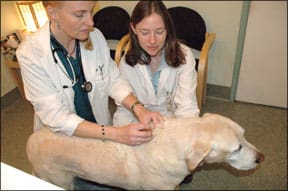
Petplan is endorsed by the Humane Society of the United States (HSUS) and offers a discount to its members.
Petplan USA
Philadelphia, PA
(866) 467-3875
Pets Best Insurance
Founded in 2005, Pets Best Insurance steers away from using benefit schedules by stating that everything is covered except the things specifically listed as an exclusion in the owner’s policy. However, the exclusion list is lengthy and includes: congenital conditions, pre-existing conditions, parasites, diseases preventable by vaccines, elective procedures, and dental care in the basic level plan.
Owners may purchase add-on coverage for some of the exclusions like annual teeth cleaning, spay/neuter, and vaccinations. As with most health insurance companies, rates are geography-based; however, Pets Best Insurance is unique in that its exclusion conditions are also based upon geography.
Pets Best Insurance
Boise, ID
(877) 738-7237
Trupanion Pet Insurance
Offered in Canada for six years, Trupanion is newly available in the U.S. Trupanion is designed to cover “major veterinary cost you can’t anticipate,” rather than “expected veterinary costs.” Plans are priced with a $0 deductible, but owners can increase the deductible level in $5 increments in order to lower their monthly premiums. The plan pays 90 percent of the veterinary bills and will not increase as the dog ages. The plans cover hereditary conditions except hip dysplasia.
Trupanion
Lynnwood, WA
(800) 569-7913
Veterinary Pet Insurance
In business since 1982, Veterinary Pet Insurance (VPI) is the oldest and largest pet health insurance company in the U.S. After the policyholder meets her deductible, VPI reimburses her based on VPI’s predetermined benefit schedule of charges for veterinary services, or the actual invoice amount, whichever is less.
Ann Melchoir, a retired law enforcement professional and longtime dog and cat owner, purchased a health insurance policy for her pets from VPI about nine years ago. “I’d give them a solid B+,” says Melchoir.
Melchoir’s monthly premium, which covers two young dogs and two cats (one who is 15 years old), costs $103 with a $50 deductible per animal. She credits VPI with good phone assistance, reimbursements received within one month of her submission of a claim, and premiums that don’t go up just because she filed a claim.
Melchoir added her Norfolk Terrier, Katie, to the policy in 2007 when the pup was nine weeks old. During Katie’s first year, she incurred about $1,690 in veterinary bills, accumulated in four separate incidents, plus Melchoir paid $187 to VPI for Katie’s first year premium. Melchoir received just $466 in insurance reimbursements. But, she adds, “VPI lost a lot of money in the last five to six years of my Standard Poodle’s life.”
Melchoir lives in Potomac, Maryland, an upscale suburb of Washington, DC. She notes that the reimbursements usually cover less than half the charges she pays to vets in her expensive area of the country. Even so, she maintains the policy for her pets. She can afford to pay for the treatments her pets require, but the insurance “takes the sting out of it.”
“I’m willing to spend extra money for peace of mind,” she says. “I insure my pets before they come in the door [to eliminate policy exclusions for pre-existing conditions]. I’m that kind of person. For those years when you have a really sick animal, it’s worth it.”
Veterinary Pet Insurance
Brea, CA
(888) 899-4874
PetInsuranceReview.com Offers Some Help
Fans of retailing websites like Amazon.com (and many others) have become accustomed to receiving a certain amount of purchasing advice from their peers, in the form of a “user review.” There are also other sites that offer only reviews, with no products offered for sale by the site owner – although the sites are generally funded by advertising income and the sites themselves may be cluttered with ads.
Here’s a site that helpfully offers tons of the former (user reviews) and none of the latter (ads from competing insurance companies): Colorado-based Pet Insurance Review. The site states that it is not owned or controlled by any pet insurance company and the user reviews “do not reflect the opinion of the operator of this website.”
Pet Insurance Review says its mission is to help pet owners make the best health insurance decisions based on pricing and benefits, and actual customer reviews. It accomplishes the first part by making it easy for an owner to get a quote and information about the various companies from the companies themselves. If you click on “Get quotes,” and fill in some basic information about yourself and your dog (your zip code, your dog’s age, breed, and sex), the site will submit simultaneous quote requests to several insurance companies, who will then e-mail their quotes to you individually.
Alternatively, if you click on the names of the various insurance companies, you jump to a page that gives contact information for that company, a basic description (provided by the company), and hyperlink to the company’s own site (where you can submit a quote request yourself). But that page also features dozens (sometimes hundreds) of user reviews of the company’s insurance products; in our opinion, this is the most useful part of the website. Here, you can read what went well, or what went badly, about pet owners’ experiences with their dogs’ medical histories and their efforts to manage the associated costs.
Things to Keep in Mind
Choosing health insurance can seen daunting, but if you really focus on your own needs, your dog’s health, and your budget, you’ll be able to determine what sort of plan has the most potential for saving you money in the long run. Consider these tips as you mull over your options:
• Consider combining a discount program (like Pet Assure) to pay help pay for routine healthcare, with a low-premium, high-deductible policy for catastrophic health events only. That way, you will receive a discount on regular veterinary charges and some supplies and services, and still have coverage for high-cost, unplanned procedures.
• Alternatively, if you are very self-disciplined, create an interest-bearing savings account to be used for your dog’s healthcare needs. Take a realistic look at how much you can afford to save; it may make sense to purchase a high-deductible, low cost policy to cover expensive emergencies, even if you are assiduous about saving money to be used for routine veterinary expenses. Once the account contains enough savings to cover the high cost of emergency healthcare, you could safely discontinue the emergency policy.
• The American Animal Hospital Association (AAHA) offers this suggestion: Ask your veterinarian (or, more likely, her front office manager) about her recommendation for insurance. Vets and their clinic managers are likely to have experience dealing with the company (and maybe even the policy) you are considering. They may be able to warn you away from companies that fail to live up to their promises, and steer you toward companies that their clients have reported being very happy with.
• Owners with multiple pets may benefit most from discount plans health insurance to provide for even regular, planned veterinary expenses.
Remember, when your dog’s veterinary care costs significantly exceed what the insurance company will reimburse – according to its schedule – it can feel as if it wasn’t worth paying for the insurance.
No matter what plan you choose, it’s incumbent on you to understand the policy thoroughly, and know how to follow the proper procedure for filing claims. A company may have very specific requirements that you must meet – turning in paperwork within a determined time period, for example – and refuse to reimburse you if you fail to meet each of its requirements.
You may also find that you have to pay scrupulous attention to the reimbursements and the accompanying explanations that you do receive, to make sure you fully understand what the company did and did not reimburse you for, and why. All insurance companies make mistakes, and if you don’t pay attention, you may find that the mistakes all seem to favor the insurance company!
One owner I interviewed thought he would get more credit on his first claim, since he had paid premiums for many years without a claim; insurance doesn’t work like that! Also, after scrutinizing the reimbursement codes, he found that he failed to get reimbursement for something that should have been covered. He complained to the company, and was told how to submit more paperwork to correct the problem and receive greater reimbursement, but felt it was too much work for too little return. Just as with their own health insurance, dog owners may have to be diligent and persistent to receive the full measure of what they are due.
Ways to Minimize Healthcare Needs
– Spay or neuter your dog.
– Provide regular preventative care to keep your dog healthy. Keep his teeth clean by brushing his teeth, and having them cleaned professionally as soon as this is needed.
– Take him to your primary care veterinarian for a checkup every year.
– Protect his mental and emotional health too. Chronic stress can affect his immune system, and make him prone to physical illness.
– Control your dog’s weight; provide him with plenty of safe exercise.
– Prevent emergencies; don’t let your dog roam unsupervised.
– Keep your dog’s safety in mind. Use a canine seatbelt or put him in a crate that is securely fastened in your car. Don’t put him in conditions where he may become subject to heatstroke or frostbite.
– Feed your dog the best food you can afford. Change his diet if it seems to cause any sort of digestive, skin or other type of problems.
PET INSURANCE: OVERVIEW
1. Think about your dog’s health, age, predisposition to accidents, and risk of inherited disease to help you decide what level of coverage you should investigate.
2. Get price quotes from every company that offers plans that seem to meet your needs.
3. Ask your veterinarian (or her office staff) about the insurance providers they like the best; they should be able t o steer you away from companies that make their paperwork difficult to complete, or who reimburse owners very slowly.
4. If possible, don’t allow your coverage to lapse if your dog is diagnosed with a condition requiring ongoing treatment; it may be excluded as a pre-existing condition later in his life.
Lorie Long runs her two Border Terriers in agility and is the author of A Dog Who’s Always Welcome (Howell Books, 2008).


